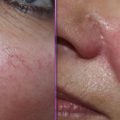Beauty Secrets
by: Maggie
Four Sneaky Tricks
1- If your skin seems dull, try a foundation with light-reflecting particles (they’re tiny, so you won’t look like a showgirl). They hide flaws and make skin look radiant. Any formula labelled illuminating, brightening, or luminous will do the trick.
2- A neutral-coloured shimmery shadow is like Spanx for crepe-y eyelids: It gives the illusion of tautness. Use a powder – not cream – shadow one shade lighter than your skin.
3- Powder blushes, which sit on the skin’s surface, can exaggerate the look of fine lines, but cream formulas sink into skin to give a dewy finish.
4- Big, sparkling eyes convey youth and happiness. No kidding! The trick: Line the inner rims of your eyes with a cream-colored eye pencil.
.
we hope you enjoy the contents…..

Until the next time,
Dr Hazem Kahlout
Ms Maggie Walsh
Registered nurse infect patients with hepatitis virus …
A registered nurse in Perth, Australia, Tiffany Fraser thought she could start a cottage industry, injecting clients with Botox and Fillers in the privacy of her home. ABC News, Australia, reports that this is the first small business of its kind detected in Australia.
Blood-borne viruses
The nurse is now being investigated by the West Australian Health Department and her clients are being tested for blood-borne viruses. After investigating her home, health officials were not able to rule out the risk of a possible infection control breach – a breach that could expose her clients to hepatitis B, C and the HIV virus. The nurse had 33 clients known to the authorities; they were all notified that they should be tested by their GP’s.
Medical Guarantee
Dr Hazem Kahlout says, “If you go to your local doctor and get an injection, it has to be sterile, the skin has to be cleaned, and a new needle and new syringes have to be used every time. There’s a whole system built around making sure that one person’s blood isn’t making contact with another person.” Outside of a medical setting, there are no guarantees that such a system exists.
Registered nurses like Fraser are not allowed to administer or prescribe these injections in Ireland without a doctor’s supervision. Botox is prescription only and must be prescribed and administered by a doctor.
Sophisticated Training
Other dangers of getting cosmetic injections in an inappropriate setting include being injected with a lethal or dangerous substance, getting no results, or getting poor results, such as a droopy lid or a bruised appearance. Aside from safety concerns, one needs sophisticated anatomical training and experience to know where and how to inject Botox.
I hope that publicity around this event will serve as a reminder to get cosmetic injections in an appropriate medical setting by a doctor who registered with the Irish Medical Council.
Topic highlight of the week…
This week we look at Vascular Lesions
Laser treatment of Skin vascular lesions has progressed significantly over the past 25 years. Based on the pioneering work of Anderson and Parrish in the early 1980s, several vascular-specific laser systems have been developed using principles of selective photo-thermolysis.
Laser beams can selectively destroy specific targets pigment within the skin by using an appropriate wavelength, pulse duration, and energy setting. Because the energy deposited in the tissue is limited to targeted vascular lesions, significant thermal diffusion to adjacent skin is prevented.
Unlike early lasers, modern systems, such as the 585-nm or 595-nm laser have become the mainstays of therapy for both congenital and acquired vascular lesions. These lasers offer excellent clinical improvement with a low risk of adverse events. Transient redness is the most common adverse effect of 585-nm laser treatment. Thanks to technological improvements including dynamic surface cooling and extended pulse duration, which enhance clinical results and minimize adverse effects.
Classification of Skin Blemishes
Skin vascular lesions are categorized according to pathology and age of onset. Congenital lesions begin in infancy and include port-wine stains, haemangiomas, venous malformations, and lymphangiomas. Acquired lesions develop in persons of any age and include telangiectasias, cherry angiomas, pyogenic granulomas, venous lakes, poikiloderma of Civatte. Acquired lesions may occur spontaneously, or they may be caused by trauma, ultraviolet exposure, or hormonal changes. At Castleknock Cosmetic Clinic we treat all acquired vascular lesions.
Telangiectasias
Telangiectasias are small, dilated vessels that are 0.1-1.5 mm in diameter. Telangiectasias commonly occur on the face and lower extremities and are due to a variety of causes. Facial telangiectasias can occur spontaneously, or they can be caused by excessive ultraviolet exposure, collagen-vascular disease, acne rosacea, pregnancy, alcohol or estrogen ingestion, or topical corticosteroid application. Children frequently develop small facial telangiectasias that persist into adulthood. Lower extremity telangiectasias are more common in women and may be genetic or may develop after pregnancy.
Treatment options are numerous and include sclerotherapy, electrodesiccation, lasers, and intense pulsed-light therapy. Shorter laser wavelengths have been found to be more effective for treating redder, more superficial vessels, but these parameters are not as successful for deeper blue venulectasia and reticular veins. The 1064-nm Nd:YAG laser has been shown to successfully improve lower extremity leg veins, especially blue venulectasia and reticular veins up to 4 mm in diameter. In one study, nearly two thirds of the patients achieved 75-100% clearing after only one laser treatment.
When sclerotherapy with 0.25% sodium tetradecyl sulphate was compared with 1064-nm Nd:YAG laser therapy for lower extremity telangiectasias (0.1-1.5 mm), significant clinical improvement was seen in all sites with either modality. However, earlier clearing and higher average improvement scores were seen with sclerotherapy. Both modalities were associated with pain and localized tissue erythema and oedema. Temporary post-inflammatory hyperpigmentation was seen only with sclerotherapy.
Despite recent advances in laser technology and the effectiveness of lasers for facial telangiectasias, treatment of lower extremity telangiectasias with vascular-specific lasers can be ineffective. Treatment failures are often attributed to the larger size and deeper site of lower extremity vessels and their association with deeper, feeding venous plexuses. For these reasons, sclerotherapy is considered first-line treatment for most telangiectatic leg veins.
Cherry angiomas
Cherry angiomas are small, well-circumscribed, bright-red vascular proliferations that initially appear in early adulthood and increase in number with age. Although benign, growths are easily treated with vascular-specific lasers to improve cosmetic appearance.
Poikiloderma of Civatte
Poikiloderma of Civatte clinically appears as a reticulated, brown pigmentation of the neck, anterior chest, and lower face with prominent telangiectasias caused by chronic sun exposure. Poikiloderma may be successfully treated with either the PDL or an intense pulsed-light source. The intense pulsed-light source may prove more helpful in eliminating associated hyperpigmentation because of its additional effect on epidermal melanin.
Venous lakes
Venous lake is a common vascular lesion characterized by elevated, usually dome-shaped papules, ranging in colour from dark blue to dark purple, seen more frequently in elderly patients. They often occur as single lesions on the ears, face, lips, or neck. Once formed, lesions persist throughout life. Although these lesions are usually asymptomatic, they can bleed if injured. The treatments available for treating this condition are cryosurgery, surgical excision, laser photocoagulation, laser vaporization, infrared coagulation and sclerosing agents. When present on the face, they are an aesthetic concern.
Testimonial
“Hello Dr Hazem,
I just had to drop a line to say wow. I had my mommy scowl and 6 pack forehead injected with Botox January. I started seeing results the very next day, it has now been 4 days and I can not remember the last time my forehead looked this smooth. I am looking forward to my next visit to show off this new rejuvenated look I have going on. I thank you for your openness about this procedure as I was feeling very guilty initially for feeling so vain about this. You gave me the opportunity to see this whole way of treatment in a new perspective and empowered me to realize I am worth it and my feelings were not vain but rather me just wanting to look on the outside the way I feel on the inside which is beautiful and youthful.
Thank you, respectfully,
Becky S.




Leave a reply